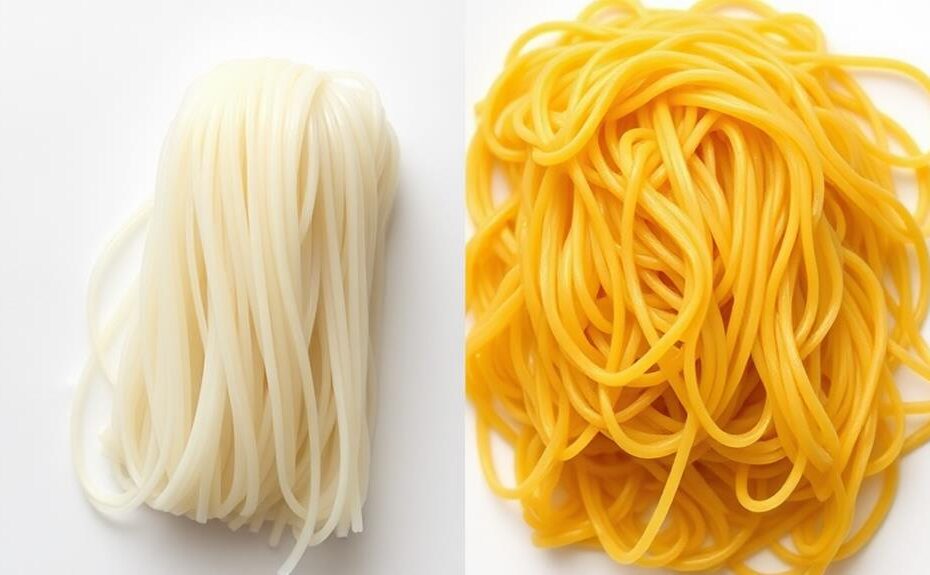Pancit bihon and pancit canton are two distinct Filipino noodle dishes. The primary difference between them lies in the type of noodles used.
Pancit bihon uses thin, translucent rice noodles, whereas pancit canton uses thicker, yellowish egg noodles. This variation affects not only the texture but also the cooking method, nutritional value, and price.
The cooking method for pancit bihon involves soaking the noodles in hot water, whereas pancit canton requires boiling the noodles. Additionally, pancit bihon tends to be lower in calories and fat compared to pancit canton.
Lastly, pancit canton is generally more expensive than pancit bihon due to the higher cost of egg noodles.
Filipino Noodle Dish Overview
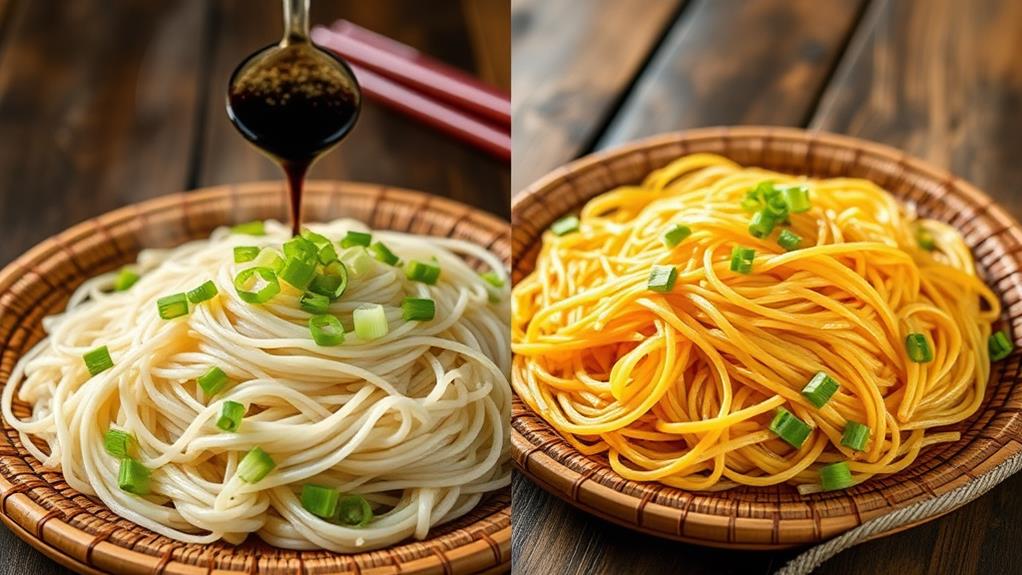
Filipino noodle dishes are beloved across the country due to the variety of noodles used, particularly in two popular dishes: pancit bihon and pancit canton.
These two types of noodles are staples in Filipino cuisine, often served at celebrations and gatherings. Pancit bihon is made from thin rice noodles, which yield a translucent appearance when cooked. In contrast, pancit canton is made from thicker egg noodles, maintaining a yellowish hue. The difference in ingredients and preparation methods results in distinct textures and flavors.
When cooking these dishes, you'll typically stir-fry the noodles with a mix of proteins and vegetables. However, the noodle type influences the overall cooking time and method. Pancit bihon is generally more economical and requires shorter cooking time, while pancit canton needs a longer cooking time due to its thicker texture.
Both noodle varieties are widely available in markets across the Philippines.
Understanding the characteristics of these two types of noodles is essential to appreciating the diversity of Filipino noodle dishes. By exploring the differences between pancit bihon and pancit canton, you'll gain insight into the cultural significance and culinary appeal of these beloved dishes.
History of Pancit in Guam
Pancit's introduction to Guam is attributed to Filipino migration during the Spanish colonial period. This influx of Filipino workers, which began in the 17th century, brought with them their culinary traditions, including pancit.
Filipino workers introduced pancit bihon and pancit canton to the local cuisine.
Post-World War II, there was a significant increase in Filipino workers, solidifying the presence of Filipino dishes in Guam. As cultural exchanges between Filipino and CHamoru communities took place, traditional pancit recipes were adapted, blending both culinary practices.
For example, local ingredients and flavors were incorporated into pancit recipes, resulting in unique regional variations.
Today, pancit dishes are staples at local fiestas and celebrations, highlighting their cultural significance. The evolution of pancit in Guam has resulted in its importance in community gatherings, where it's often served alongside other traditional dishes.
Pancit's cultural significance is evident in its presence at local celebrations, where it brings people together and showcases the community's cultural heritage.
Noodle Types and Characteristics
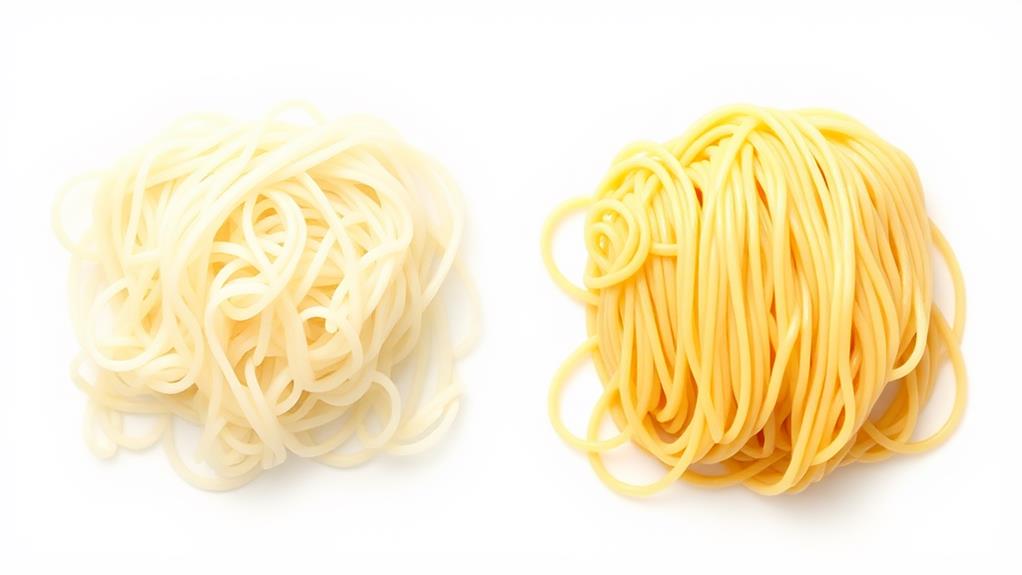
Two Primary Types of Noodles in Pancit Dishes
Pancit bihon and pancit canton are the two popular types of noodles used in pancit dishes.
Pancit Bihon Noodles
Pancit bihon noodles are made from rice flour and cornstarch, resulting in thin, translucent, and delicate noodles.
This combination gives them a perfect texture for soaking up flavors. When cooked, bihon noodles become soft and pliable, absorbing flavors easily.
They're also generally more budget-friendly than canton noodles.
Pancit Canton Noodles
Pancit canton noodles, on the other hand, are made from wheat flour and eggs, resulting in thicker, egg-based noodles with a yellowish hue.
This sturdier consistency holds up well to cooking and maintains its texture. When cooked, canton noodles keep their firmer texture and don't change color.
Key Differences and Uses
Despite their differences, both types of noodles are staples in Filipino cuisine.
Pancit bihon often stars in stir-fries, while pancit canton is frequently used in savory noodle dishes.
Cooking Methods and Steps
Mastering Cooking Methods and Steps for Pancit Bihon and Pancit Canton
To achieve harmony in the kitchen, it's essential to understand the cooking methods and steps for pancit bihon and pancit canton.
Pancit bihon requires soaking rice noodles in water for 10 minutes to absorb flavors and soften properly, whereas pancit canton's egg noodles can be cooked directly in the stir-fry without pre-soaking.
The cooking method for both dishes starts with sautéing garlic and onions as a flavor base.
Then, add proteins like chicken, shrimp, or pork, followed by vegetables and noodles.
The final step involves tossing the cooked noodles with the sautéed mixture, ensuring even distribution of flavors and allowing the noodles to absorb the sauce.
Nutritional Information and Values
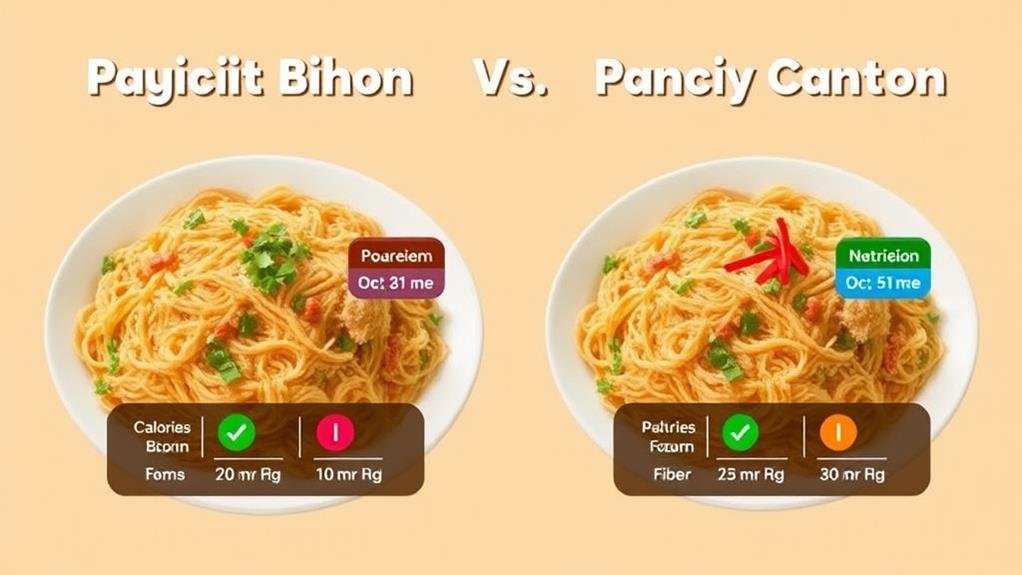
Pancit Bihon: A Lower-Calorie Option
One serving of pancit bihon generally contains fewer calories than pancit canton due to its thinner rice flour noodles, which absorb less oil and sauce during cooking. This results in lower calorie consumption with pancit bihon.
Gluten-Free and Protein Content
Pancit bihon is made from rice flour and cornstarch, making it a gluten-free option suitable for those with gluten intolerance or sensitivity.
While pancit canton has a higher protein content due to its egg-based noodles, pancit bihon still provides a significant amount of protein from added meat and seafood ingredients.
Nutrient-Rich Ingredients
Both pancit bihon and pancit canton incorporate a variety of vegetables, which enhance their nutritional profiles by providing vitamins and minerals essential for a balanced meal.
The cooking methods for both dishes help maintain the nutrients in the ingredients, making them wholesome options suitable for gatherings and celebrations.
Comparison of Nutritional Values
Similarities Between Pancit Varieties
Pancit Bihon and Pancit Canton Share Cultural Significance
Both Pancit Bihon and Pancit Canton are staples during special occasions, such as birthdays, weddings, and holidays, highlighting their importance in Filipino culture.
Similar Ingredients and Flavors
Both dishes frequently feature similar ingredients, including pork, shrimp, and a variety of vegetables, which showcase a blend of flavors and textures.
Chinese Roots and Adaptation
Both Pancit Bihon and Pancit Canton have roots in Chinese cuisine, introduced to the Philippines through trade, and have since adapted to local culinary practices.
Stir-Frying Method
They're typically prepared using a stir-frying method, allowing for a quick and flavorful cooking process.
Common Foundation in Filipino Cuisine
These similarities demonstrate that, despite the differences in noodles used, Pancit Bihon and Pancit Canton share a common foundation in Filipino cuisine.
They're both beloved dishes that bring people together, often served in a traditional bilao to emphasize their role as communal dishes enjoyed by family and friends.
Differences in Noodle Texture
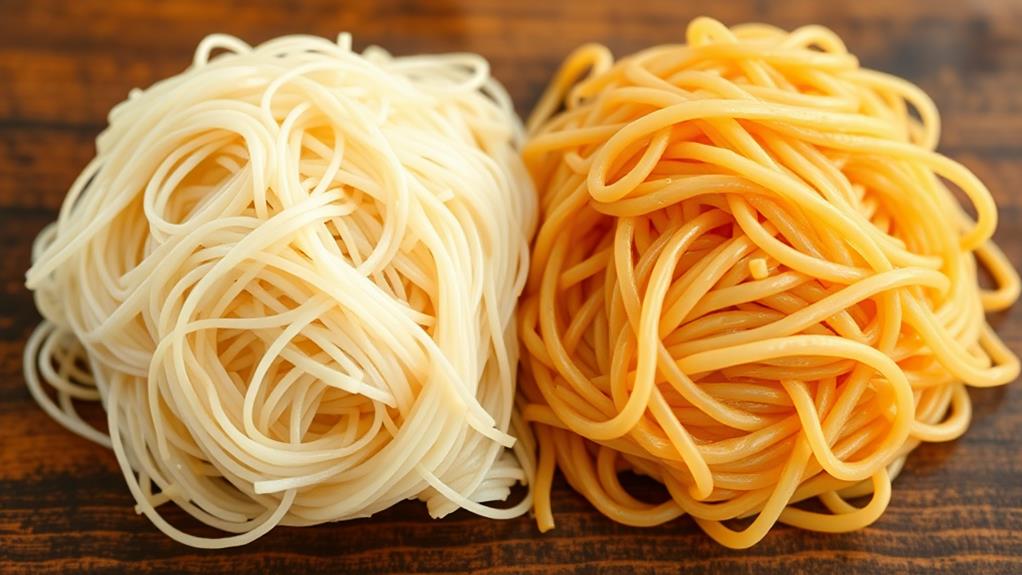
Pancit Bihon and Pancit Canton noodles have distinct textures due to their different ingredients.
Pancit Bihon noodles are made from rice, making them incredibly thin and glass-like, with a delicate texture that becomes translucent when cooked. In contrast, Pancit Canton noodles are made from wheat flour and eggs, resulting in thicker noodles with a slightly firmer texture.
The texture difference affects how the noodles interact with flavors and cooking methods.
Bihon noodles readily absorb flavors from sauces and broths, enhancing the overall taste of the dish. On the other hand, Canton noodles maintain a firmer texture and chew.
When cooking, Bihon noodles must be sautéed quickly to prevent them from becoming mushy, whereas Canton noodles can withstand a longer cooking time due to their sturdiness.
The visual difference is also apparent.
Cooked Bihon appears glossy and translucent, while cooked Canton remains yellowish and opaque, reflecting their differing compositions and textures.
This distinct noodle texture is a key factor in the overall character of each pancit variety.
Pricing and Cost Comparison
Pricing and Cost Comparison
When it comes to pricing and cost comparison, Pancit Bihon is generally more affordable than Pancit Canton. This price difference is attributed to the basic ingredients used in each noodle type, with rice being less expensive than wheat and egg.
Local market availability significantly impacts the pricing of both noodle types. Pancit Bihon is frequently found at lower prices in many regions.
On average, a pound of Pancit Bihon can cost around $1.50 to $3.00, while Pancit Canton may range from $2.00 to $4.00 per pound, depending on the brand and quality.
Seasonal variations and regional demand also affect the cost of both types of noodles. Pancit Bihon is often the go-to option for economical meal planning due to its consistent affordability.
Other Popular Pancit Recipes
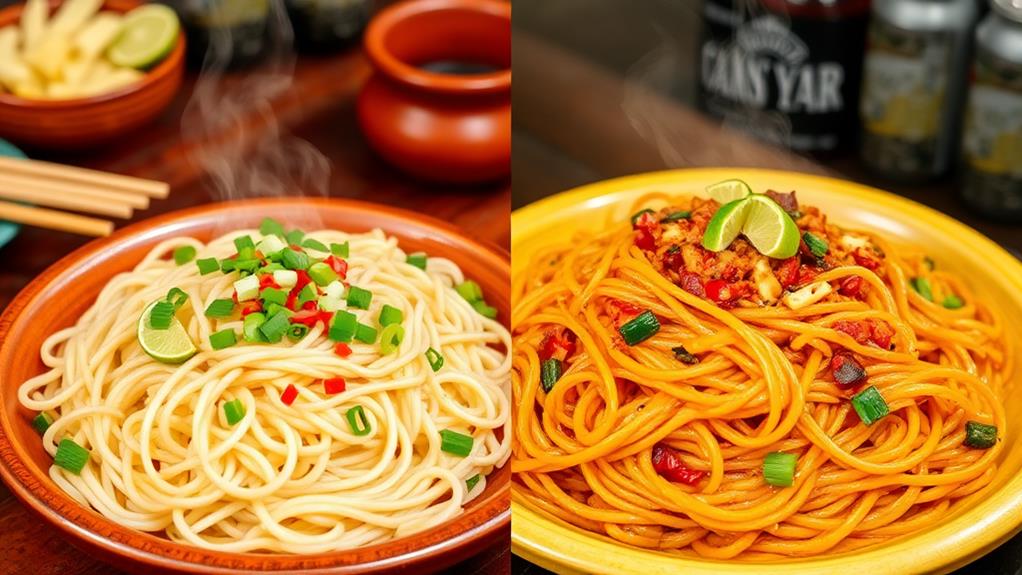
Exploring the Diversity of Filipino Noodle Dishes
The Philippines is home to a variety of pancit recipes, each with its unique flavor profile and ingredients. Five popular pancit recipes showcase the diversity of Filipino noodle dishes.
| Pancit Recipe | Description |
|---|---|
| Pancit Sotanghon | Made with mung bean noodles, savory broth, and garnished with shredded chicken and vegetables |
| Pancit Palabok | Rich shrimp sauce, served on a bed of rice noodles, garnished with hard-boiled eggs, chicharrón, and green onions |
| Pancit Lucban | Known for its distinct flavor profile, incorporating local ingredients like longganisa, often served during the Pahiyas Festival |
Beyond familiar recipes like pancit bihon and pancit canton, other variations offer a chance to experience authentic pancit in new ways. For example, Pancit Lomi features thick egg noodles in a hearty sauce, while Pancit Habhab has a unique twist with vinegar and banana leaves. Each dish is a testament to the creativity and diversity of Filipino cuisine.
What are the main differences between Pancit Bihon and Pancit Canton?
Pancit Bihon and Pancit Canton are two popular variations for pancit noodles in Filipino cuisine. The main difference lies in the type of noodles used. Pancit Bihon features thin rice noodles, while Pancit Canton uses thick egg noodles. Each offers a unique texture and flavor to this traditional dish.
Cultural Significance in Filipino Cuisine
Pancit's Cultural Significance in Filipino Celebrations
In Filipino celebrations, pancit dishes like Pancit Bihon and Pancit Canton symbolize good fortune and well-being, taking center stage as a staple food. Beyond its delicious taste, pancit holds cultural significance that reflects the values and traditions of Filipino cuisine.
Long noodles represent longevity, reflecting the importance of health and prosperity for those who enjoy the meal. This symbolism is rooted in the idea that long, unbroken noodles ensure a long and healthy life.
Pancit preparation fosters community and bonding, highlighting the importance of family and social ties. The communal preparation of pancit encourages teamwork, cooperation, and social interaction among participants, strengthening relationships and creating lasting memories.
Pancit dishes showcase historical trade connections that introduced noodles to the Philippines. The fusion of Chinese and Filipino culinary traditions in pancit dishes like Pancit Bihon and Pancit Canton serves as a testament to the cultural exchange and trade that shaped Filipino cuisine.
Frequently Asked Questions
What Are the Two Types of Noodles in Pancit?
Pancit dishes typically feature two main types of noodles: rice noodles and egg noodles.
Rice noodles are thin and delicate, becoming translucent when cooked. They provide a soft bite and have a neutral flavor profile. This means they absorb the flavors of the dish without overpowering them.
Egg noodles, on the other hand, are thicker and sturdier. They retain their yellowish color even after cooking and offer a more robust flavor. This makes them a great addition to pancit dishes, adding depth and complexity to the flavor profile.
What Is the Most Popular Pancit in the Philippines?
Pancit Bihon is the most popular pancit in the Philippines.
While regional preferences and cooking techniques vary, many Filipinos agree that Pancit Bihon takes the top spot. This is due to its light, rice-based noodles that are expertly cooked to absorb flavors, making it a hit at family gatherings and festivities.
The delicate texture of Pancit Bihon's noodles wins over hearts, making it a beloved classic in Filipino cuisine.
What Is the Difference Between Pancit Luglug and Bihon?
Pancit Luglug and Bihon are two distinct types of Filipino noodles. They differ in terms of noodle thickness, ingredients, and cooking methods.
Luglug features thick rice noodles, typically served with a rich shrimp sauce and savory broth.
Bihon, on the other hand, boasts thin noodles, often sautéed with various proteins and vegetables.
Regional variations play a significant role in the availability of these noodles. Luglug is commonly found in specific areas and festivities, whereas Bihon is more widely available.
The flavor profiles of these noodles also differ. Luglug's thick sauce coats the noodles, giving it a rich and savory flavor.
In contrast, Bihon's lighter stir-fry style results in a more delicate taste.
What Is the Difference Between Pancit Bihon and Sotanghon?
Pancit Bihon noodles are made from rice flour and cornstarch, resulting in thin, translucent noodles. These noodles, influenced by Chinese cuisine, are commonly used in Filipino cooking.
Sotanghon noodles, on the other hand, are made from mung bean starch and have a distinct glassy texture. This type of noodle is also popular in Filipino cuisine, but its texture sets it apart from Bihon.
Regional variations in cooking methods exist between the two noodles. Bihon is often stir-fried, which helps to bring out its delicate flavor.
In contrast, Sotanghon is typically used in soups, where it absorbs flavors from the broth.
When cooked, Bihon noodles turn translucent, whereas Sotanghon retains its glassy appearance. This visual difference is a key distinction between the two types of noodles.
